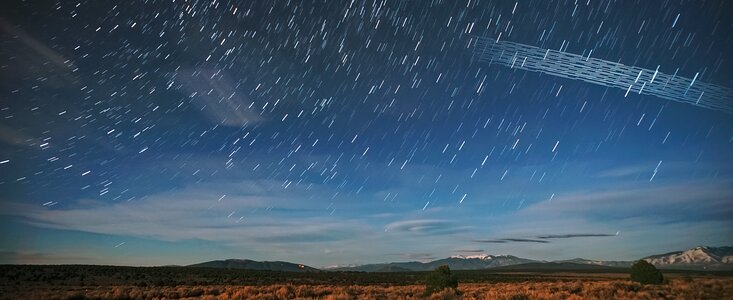Satellite Constellations
“Satellite light pollution” has technically existed since the first artificial satellites were launched into orbit more than 60 years ago, but with the advent of multiple large satellite constellations made up of hundreds or thousands of small, low-orbiting satellites meant primarily for broadband Internet access, the number of artificial satellites around Earth is projected to increase by several orders of magnitude in the next decade alone. As the number of satellites continues to grow, astronomy is facing a tipping point situation of increasing interference with observations and loss of science. By the end of the 2020s, more than 5,000 satellites will be above the local horizon at any given time at a typical dark-sky observatory location.
There will likely soon be hundreds of newly launched satellites on the way up to their final orbit at any given moment, visible to the unaided eye, particularly low on the horizon and in twilight hours when they are still illuminated by sunlight.
While the majority of constellation satellites are invisible to the unaided eye (especially in regions that are already light-polluted), the sensitive and time-exposed sensors on astronomical detectors and cameras can still pick them up. They leave traces of their transit on astronomical images, significantly decreasing the scientific usability of the collected data. Post-processing of the affected images only partially remedies the problem: the brighter trails may saturate or “blow out” the camera detectors, making portions of some images unusable, while the removal of the fainter trails leaves residual effects that seriously affect important scientific programs. Examples include statistical, automated surveys of faint galaxies where the smallest change to a pixel or two may seriously affect the validity of data.
Starlink Satellites over Carson National Forest, New Mexico, photographed soon after launch.
Credit: M. Lewinsky/Creative Commons Attribution
As well as active satellites there are thousands of inactive satellites and 41,000 trackable pieces of space junk, as well as at least 600,000 smaller pieces of debris from 1-10 cm in size, all of which contribute to a slight increase in the brightness of the background of the sky. The situation can be quickly made exponentially worse if there are satellite collisions. Such collisions lead to clouds of debris — or worst case even cascading collisions — which can increase the general sky brightness, making it more difficult to see distant celestial objects. It is therefore critical to avoid major collisions of satellite constellations. The experts are mindful of different pathways for recommendations for regulators but have not converged on which actions to take.
The impact of large satellite constellations on optical/infrared astronomy is also affecting telescopes with large fields of view as well as the automated searches for fast-moving objects, like the International Asteroid Warning Network (IAWN), a program initiated and supported by the UN Office of Outer Space Affairs and aimed at detecting potentially hazardous near-Earth objects (NEOs): asteroids and comets that may impact Earth at some point in the future. NOIRLab is helping to organize efforts to mitigate the impact of satellite constellations on astronomical research by making real-time measurements of satellite brightness, engaging with satellite manufacturers and operators to physically reduce the brightness of satellites, and coordinating, developing, and sharing software to both remove satellite streaks from images and better predict their paths to plan observations around them.
Some of the guidelines established by a collaboration of industry members and astronomers for optical astronomy include:
- Keeping individual satellites as dark as possible, preferably below unaided eye visibility (fainter than magnitude 7)
- Reducing reflectivity of surface materials and satellite structure
- Reducing general visibility of satellites
- Minimizing overall number of satellites when possible
- Keep orbital altitudes below 600 km - higher orbiting satellites are visible later into the night
- Adjusting on-orbit attitude (i.e., don’t reflect light on an observatory)
- Considerations during orbit raise and de-orbiting to keep satellites as dim as possible by orienting reflective surfaces such as solar panels and antennae
- Providing highly accurate, publicly available data on satellite locations to aid in planning observations around satellites
The impact of satellite constellations on radio astronomy is also of great concern. Radio telescopes observe at specific frequencies that are largely protected by the International Telecommunication Union. However, the situation created by the new large constellations of telecommunication satellites poses new threats to radio astronomy that deserve further study.

